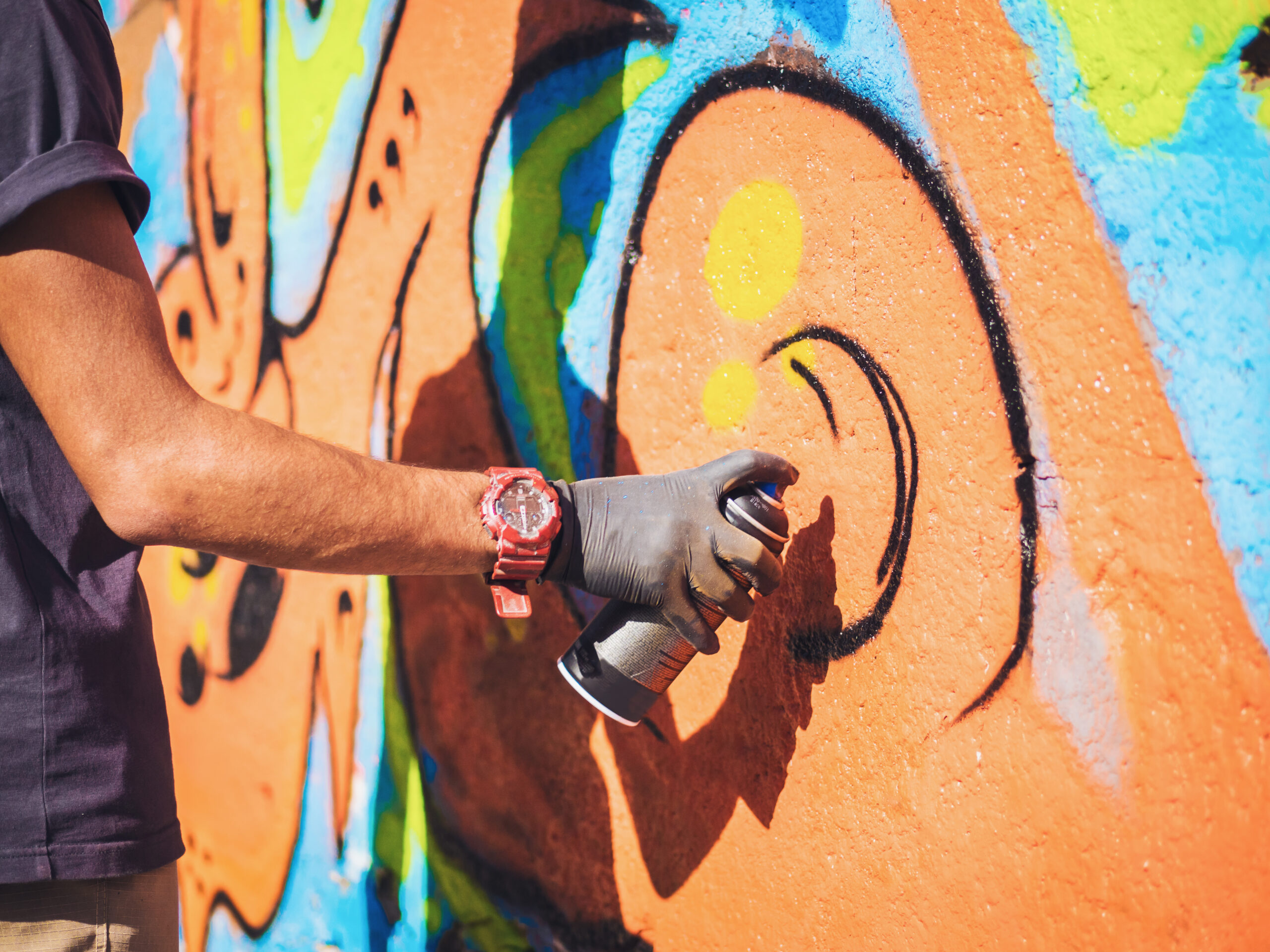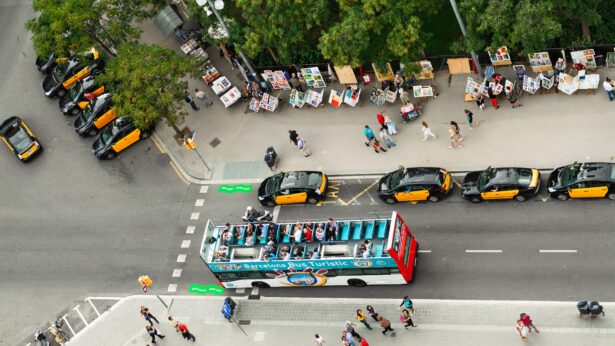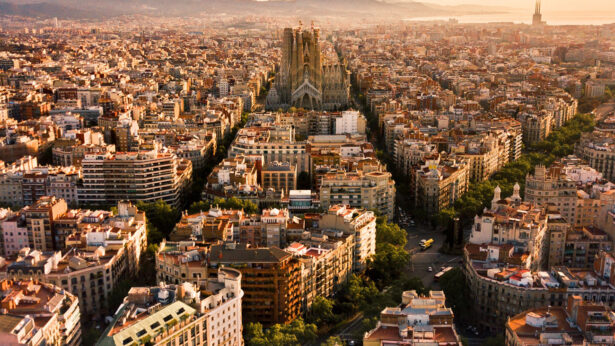The Musik Boutique Hotel is a modern oasis in the heart of Barcelona. Located near iconic urban art spots like the Gothic Quarter and El Raval, this hotel combines contemporary design with a unique connection to the city’s vibrant artistic atmosphere, making it an ideal base for discovering Barcelona’s most iconic murals and graffiti. Keep reading this article from the Barcelona Guide by Musik Boutique Hotel to learn everything about the city’s street art!
History of Urban Art in Barcelona
Urban art in Barcelona emerged in the 1970s and 1980s as a form of protest and artistic expression. With the arrival of democracy and events like the 1992 Olympic Games, the city became one of Europe’s street art capitals, transforming industrial spaces into open-air canvases. Iconic artists like El Xupet Negre and Pepe Otal fueled the movement, which continues to evolve by blending local and international influences—positioning Barcelona as a global reference in urban art.
Where to Find the Best Graffiti and Murals in Barcelona
Barcelona is truly an open-air museum where works by local and international artists coexist. Here’s a list of the most famous murals and graffiti you shouldn’t miss:
- La Escocesa (Poblenou)
La Escocesa is a former industrial factory turned artistic creation center in Poblenou. Its outer walls are covered in massive murals and graffiti that blend industrial history with contemporary and experimental flair. Artists like Zosen Bandido and Ruben Sánchez have left their mark here, making La Escocesa a reference point for urban art. - The Kiss (Gothic Quarter)
Known as The Kiss Mural, this piece was created by Joan Fontcuberta in 2014 to commemorate the Tricentennial of the War of Spanish Succession. Made up of 4,000 ceramic photo tiles contributed by citizens, it forms a monumental kiss that symbolizes freedom and coexistence. Located in Plaça d’Isidre Nonell, it’s admired for both its beauty and powerful message. - Teatre Arnau (Ciutat Vella)
Built in the early 20th century, the Teatre Arnau is a cultural landmark of Barcelona. Although currently under restoration, its walls have become a canvas for street artists. The murals here pay homage to the theatre’s history and important figures, blending street art and cultural heritage. - Keith Haring Mural (Raval)
This mural is a replica of the original created in 1989 by Keith Haring, symbolizing the fight against AIDS. The original, painted in just five hours using only red lines to depict intertwined bodies, was recreated in 2014 near the MACBA to preserve the artist’s legacy and message. - Gats (Raval)
Meaning “cats” in Catalan, this mural in the heart of Raval was created by renowned street artist C215. Using stencil technique, it captures the expressions of stray cats—symbols of independence and urban life. - Graffiti at Las Tres Chimeneas (Poble-sec)
One of the few legal graffiti zones in Barcelona, Las Tres Chimeneas in Poble-sec is a meeting point for artists from around the world. Murals here are ever-changing, ranging from classic wildstyle to abstract pieces. Artists like Kram, La Castillo, and H101 have contributed, making this a prime example of urban art revitalizing public spaces. - El Xupet Negre (Various Locations)
Created in the 1990s, El Xupet Negre is one of Barcelona’s most recognizable urban art icons. The black pacifier symbol stands for childhood, creativity, and rebellion. You can spot it in neighborhoods like Gràcia, Poblenou, and Raval. With a minimalist style and vivid colors, it has become an international reference in logo art. - La Bartola (Raval)
This mural pays tribute to local traditions and Catalan popular culture. Created by artists from the Catalan street art movement, La Bartola blends vibrant colors and realistic elements, turning forgotten urban spaces into artistic landmarks. - Murals of Poblenou
Poblenou is a true outdoor art gallery filled with murals and graffiti. It features a mix of surrealism and figuration, with artists like Aryz and colorful, dynamic works by Ruben Sánchez. The neighborhood also hosts the Open Walls Festival, where artists and the public engage in the creative process. - The Woman on the Wall (El Born)
Created by BTOY (Andrea Michaelsson), this mural honors strong, iconic women throughout history. Using stencil techniques and blending realism with vintage style, the mural adds a nostalgic touch. Found on walls in El Born (where the Musik Boutique Hotel is located), it’s a hidden gem for those strolling by. - Àgora Juan Andrés Benítez (Raval)
This community space honors a local resident whose death in 2013 sparked a wave of solidarity. Its walls are covered in murals and graffiti reflecting themes like social justice, historical memory, and community engagement. - Museu a Cel Obert (Sant Andreu)
This project transforms walls in Sant Andreu into massive murals. It includes abstract and geometric works by artists like Zosen Bandido and Ruben Sánchez. The museum also organizes events that turn the neighborhood into a dynamic and accessible cultural hub. - Carrer Pere IV (Poblenou)
Pere IV Street is a must-see destination in Poblenou for urban art lovers. Artists like Axel Void and Miss Van have created large-scale murals here, reflecting the contrast between the area’s industrial past and its artistic transformation. - The Faces of Gràcia (Gràcia Neighborhood)
These small artistic interventions depict anonymous faces on walls, corners, and facades throughout Gràcia. They add a human, creative touch to the cityscape and are created by emerging artists, making Gràcia a perfect spot to explore. - Welcome to Barcelona (Port Fórum)
Created by Aryz, this mural in Port Fórum subtly critiques mass tourism. It uses soft colors and a mix of realism and abstraction to portray enigmatic figures, offering a visually powerful reflection on the city.
Routes to Discover Urban Art in Barcelona
If you want to explore Barcelona’s street art on foot or by bike, here are some recommended routes:
- Poblenou Route
Starting at Parc del Centre de Poblenou, this route continues along Pere IV Street. You’ll see huge murals in old factories—perfect for photos and visual experiences. - Raval and Gothic Quarter Route
Begin at Rambla del Raval, passing by local artists’ works and impressive pieces in small alleys. It ends at the MACBA mural, another urban icon. - Poble-sec and Montjuïc Route
For those interested in Las Tres Chimeneas, this route is ideal. As the art constantly changes, you’ll head up toward Montjuïc to discover hidden murals on historic buildings. - Sant Andreu Route
This final route explores the outdoor art museum in Sant Andreu, continuing through the neighborhood’s quieter streets.
These routes blend art, history, and culture—ideal for both locals and visitors.
Famous Murals and Graffiti in Barcelona That No Longer Exist
Urban art is ever-changing due to its ephemeral nature. Some of Barcelona’s most iconic murals and graffiti have disappeared over time, leaving behind only memories and photographs. Here are a few:
- Keith Haring Mural in Raval (1989)
The original mural by Keith Haring, painted in 1989 to symbolize the fight against AIDS, eventually disappeared. It was replicated in 2014 near MACBA to preserve the artist’s legacy. - The Kiss Mural in Plaça d’Isidre Nonell
Created in 2014 by Joan Fontcuberta, this mosaic collage of 4,000 photos symbolizing freedom and coexistence suffered damage and vandalism over time. It was partially removed and restored, though not fully preserved. - Graffiti at La Carbonería
La Carbonería was a famous squatted space in Eixample that served as a canvas for activist art. It was evicted and demolished in 2014, ending its chapter as a landmark of urban culture. - Murals at Can Ricart Factory in Poblenou
Once a major reference for urban art in Barcelona, the Can Ricart factory was covered in graffiti and murals. Urban renewal and gentrification erased most of the artwork, leaving little trace of this iconic space.
These examples reflect the fragile nature of street art—but also its resilience, as it continues to be reborn in new spaces.




